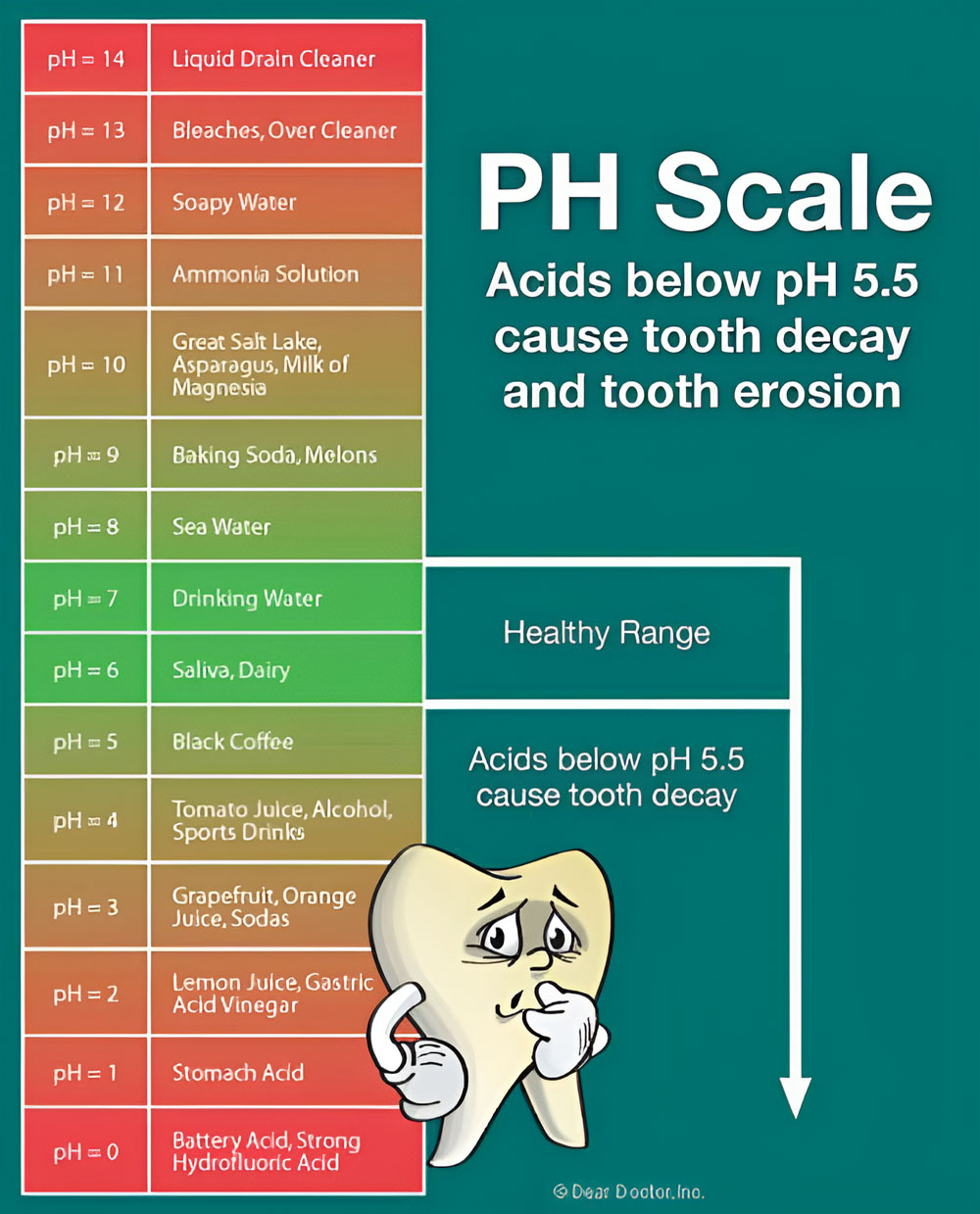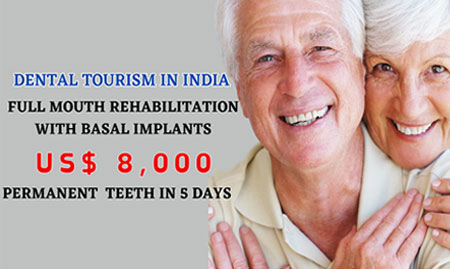
Dr. K Sharada Reddy, Author
Senior Dentist & Full Mouth Rehabilitation Expert
Saliva, often overlooked, plays an essential role in maintaining oral health and protecting teeth from decay. One of its most significant properties is its PH level, which determines whether the environment in the mouth is acidic, neutral, or alkaline. The PH scale ranges from 0 to 14, with 7 being neutral. A healthy salivary pH typically falls between 6.2 and 7.6. However, when the PH drops below 5.5 a point known as the “critical PH” the risk of dental caries dramatically increases. At this acidic level, the minerals that make up tooth enamel begin to dissolve, leading to demineralization and, eventually, cavities.

The process begins when we consume sugary or starchy foods. Oral bacteria, particularly Streptococcus mutans, metabolize these sugars and produce acids as a byproduct. These acids lower the PH of saliva, creating an environment where enamel starts to erode. If acidic conditions persist, demineralization outpaces the natural repair process, resulting in tooth decay. On the other hand, when salivary PH remains neutral or slightly alkaline, it encourages remineralization. In this state, minerals like calcium and phosphate, naturally present in saliva, are redeposited onto the enamel surface, reversing early damage and preventing the progression of caries.
Several factors can influence the PH of saliva, including diet, hydration, frequency of eating, oral hygiene habits, stress levels, and certain medications. Frequent consumption of acidic beverages such as sodas, citrus juices, and sports drinks can significantly lower the salivary PH. Similarly, dry mouth or reduced saliva flow—a condition known as xerostomia-makes it harder for the mouth to neutralize acids, further increasing the risk of cavities. This is why individuals with medical conditions or those on medications that reduce saliva flow often experience higher rates of tooth decay.
Saliva also contains important buffering agents like bicarbonates, which help neutralize acids and stabilize oral PH. Additionally, it contains enzymes and antimicrobial proteins that inhibit the growth of acid-producing bacteria. When saliva flow is adequate and its pH is balanced, it can naturally counteract harmful acid attacks and maintain a healthy oral environment. Conversely, when the buffering capacity is overwhelmed due to frequent acid exposure, the protective function of saliva diminishes.
Maintaining an optimal salivary PH is key to preventing dental caries. Some effective ways to achieve this include drinking plenty of water, chewing sugar free gum to stimulate saliva flow, reducing the intake of acidic and sugary foods, and practicing consistent oral hygiene. Using fluoride toothpaste can also enhance remineralization and strengthen enamel. In clinical settings, dentists may assess a patient’s salivary PH to evaluate their risk for dental caries and recommend preventive measures accordingly. For high-risk individuals, specialized products such as PH-neutralizing mouthwashes, remineralizing agents, and dietary guidance can make a significant difference.
Ways to Measure Salivary PH
- PH Indicator Strips (Litmus Paper): Inexpensive and easy to use; ideal for home or chairside use. These provide a general PH estimate.
- Digital PH Meters: More accurate, used with proper calibration and care.
- Chairside Salivary Tests (in Clinics): Tools like GC Saliva-Check Buffer and CRT® Bacteria kits assess PH, buffering capacity, and bacterial load to determine caries risk.
Best Practices: Measure pH 30 minutes after meals or brushing, use morning samples, and collect unstimulated saliva for consistent results.
Why Measure Salivary PH? Monitoring salivary PH helps identify patients at high risk for dental decay, assess the impact of dietary and medication changes, and evaluate the effectiveness of preventive or remineralization therapies.
LBR Dental & Implant Center in Hyderabad, India, goes beyond conventional dental care by offering cutting-edge solutions for full mouth rehabilitation, cosmetic dentistry, and immediate loading dental implants. International patients opting for Dental tourism India can benefit immensely by saving up to 70% on treatments such as Affordable dental implants in India, Invisalign and smile makeovers without compromising on quality. The clinic’s proprietary CPBCCI Protocol™ (Crestal Polished Bi-Cortical Conventional Implant Protocol) allows for graftless, immediate loading of implants, even in cases with severe bone loss, eliminating the need for sinus lifts or long healing periods. By focusing on using the patient’s native bone and bypassing bone grafting procedures, LBR Dental ensures faster recovery, less discomfort, and exceptional long-term results. For those seeking world-class dental care at affordable prices, LBR Dental & Implant Center is a leading destination in India’s growing dental tourism landscape.
Book Your Free virtual Consultation Today
Considering full mouth dental implants India but concerned about bone loss, sinus lifts, or basal implant complications? Avoid unnecessary sinus lifts and bone grafts. Discover how we place conventional implants without waiting or grafting, even in severe bone loss cases.
LBR Dental & Implant Center, Hyderabad, India
www.lbrdentalimplants.com
[email protected]
Call/WhatsApp: +91-98490 08623
Frequently Asked Questions (FAQs)
The normal salivary PH ranges from 6.2 to 7.6, with 7 being neutral. Maintaining a neutral or slightly alkaline PH is important because it supports remineralization of tooth enamel and helps prevent dental caries. A drop below PH 5.5 is considered the critical PH, at which enamel begins to demineralize.
When the PH of saliva drops below 5.5, it becomes acidic enough to start dissolving the enamel. This demineralization process weakens teeth and creates an environment where bacteria like Streptococcus mutans thrive, leading to cavities and dental caries.
Consumption of sugary or starchy foods, acidic beverages, poor oral hygiene, dry mouth (xerostomia), certain medications, and high stress can reduce salivary PH. Bacteria metabolize sugars and produce acids, which lower the PH and increase the risk of tooth decay.
You can use PH indicator strips (litmus paper) to test your saliva. Collect a sample at least 30 minutes after eating or brushing, dip the strip in the saliva, and compare the color change to the provided scale. For more accurate readings, a digital pH meter can be used.
Yes, when salivary PH is neutral or slightly alkaline, it promotes remineralization. Minerals like calcium and phosphate in the saliva can be redeposited onto the enamel, helping repair early-stage cavities naturally.
Drink plenty of water
Chew sugar-free gum to stimulate saliva
Reduce intake of acidic or sugary foods
Maintain good oral hygiene
Avoid frequent snacking
Use fluoride toothpaste and possibly PH-balancing rinses
The CPBCCI Protocol™ (Crestal Polished Bi-Cortical Conventional Implant) is a graftless technique for immediate loading of dental implants. A stable oral environment, including healthy salivary PH, contributes to better healing and implant integration, making this method highly effective and minimally invasive-even in patients with bone loss.
Yes, xerostomia reduces saliva flow, which diminishes the mouth’s natural buffering ability. This leads to lower PH, higher bacterial activity, and increased risk of cavities and gum disease. Managing dry mouth is essential to maintain a healthy oral PH and protect dental implants.
International patients save up to 70% on dental implants, cosmetic dentistry, and aligners compared to prices in the US, UK, or Australia. Using advanced protocols like CPBCCI, the clinic offers immediate loading implants without bone grafts, ensuring faster, more affordable, and less traumatic solutions with world-class outcomes.
Yes, fluoride strengthens enamel and promotes remineralization, making teeth more resistant to acid attacks. It doesn’t directly raise PH, but it helps protect teeth from damage when acidic conditions occur.
LBR Dental offers:
Saliva testing and risk assessment
Dietary counseling to minimize acidic food intake
Use of fluoride, remineralizing agents, and pH-neutralizing rinses
Immediate loading implants to replace decayed or lost teeth in just 3–5 days
Ongoing patient education for sustainable oral health




